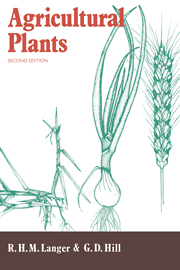Book contents
- Frontmatter
- Contents
- Preface to the first edition
- Preface to the second edition
- 1 World population and crop production
- 2 Plant structure
- 3 Liliaceae
- 4 Poaceae
- 5 Apiaceae
- 6 Asteraceae
- 7 Brassicaceae
- 8 Cannabinaceae
- 9 Chenopodiaceae
- 10 Cucurbitaceae
- 11 Fabaceae
- 12 Lamiaceae
- 13 Linaceae
- 14 Malvaceae
- 15 Papaveraceae
- 16 Solanaceae
- 17 Physiological basis of yield
- Index of specific names
- Subject index
17 - Physiological basis of yield
Published online by Cambridge University Press: 05 June 2012
- Frontmatter
- Contents
- Preface to the first edition
- Preface to the second edition
- 1 World population and crop production
- 2 Plant structure
- 3 Liliaceae
- 4 Poaceae
- 5 Apiaceae
- 6 Asteraceae
- 7 Brassicaceae
- 8 Cannabinaceae
- 9 Chenopodiaceae
- 10 Cucurbitaceae
- 11 Fabaceae
- 12 Lamiaceae
- 13 Linaceae
- 14 Malvaceae
- 15 Papaveraceae
- 16 Solanaceae
- 17 Physiological basis of yield
- Index of specific names
- Subject index
Summary
In the preceding chapters of this book we have become acquainted with the major crop plants of the temperate and subtropical regions of the world, we have learnt something of their structure and life cycle and we have begun to appreciate their place in agriculture. This knowledge, useful though it must be accepted to be, is but the first step along a much longer path which ultimately leads to the production of field crops and the utilisation of their end products. We have, in a sense, merely acquired the necessary vocabulary of a language but we still have to learn its grammar before we can begin to speak it. The next move is to fit the plants into an agricultural system – a complex amalgam, determined by climate, soils, management practices, economic constraints and consumer demand. This is undoubtedly quite a different task, requiring expert knowledge of a great variety of fields covering a very broad spectrum. Not only that, but the factors to be considered will vary widely from region to region. Crop production must ultimately be viewed in a local, geographically defined context, even though there will undoubtedly be re-occurring themes which are common to most situations. However, before we reach this level of organisation, we should do well to consider some universally applicable principles underlying the growth and productivity of plants wherever they may be cultivated and irrespective of the purpose for which they are being grown.
- Type
- Chapter
- Information
- Agricultural Plants , pp. 328 - 349Publisher: Cambridge University PressPrint publication year: 1991



